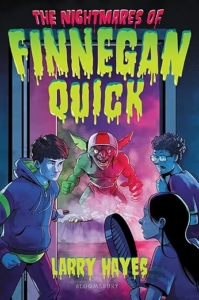The Nightmares of Finnegan Quick
Larry Hayes
Bloomsbury USA Children’s
Published August 5, 2025
Amazon | Bookshop | Goodreads
About The Nightmares of Finnegan Quick
‘I absolutely loved this book! Genuinely chilling and a little bit gory … such a fun read’ – Jennifer Killick, author of Crater Lake.
By night, Finn has horrible nightmares. By day, they come TRUE! A gripping horror story for readers of 10 and over.
Finnegan Quick is haunted by nightmares. They’re so bad, he’s terrified of going to sleep. Because Finn’s dreams change the waking world too. He’s already lost his mum, his dad, his dog, even his shadow. And now they’re coming for his gran, the only family he’s got left.
Then a mysterious girl starts appearing in his dreams, helping Finn fight back against the creatures in his nightly adventures. On the first day of the new term, she turns up at school, right there in real life, in the lunch queue!
Cass tells Finn that she has come to solve the mystery of Finn’s missing parents. Together with Finn’s geeky best friend Squid, they travel through the nightmare world, battling goblins, ghosts and zombies. Finn, Cass and Squid are a sparky, wise-cracking trio, but even together, can they prove to be a match for the creatures of the night?
If Finnegan Quick is to save the people he cares about most, he has to remember the lesson his gran has been teaching him all his life. He must learn to face his fears – or be destroyed by them!
‘Stuffed full of awesome adventure and superior supernatural chills’ – Keith Gray, author of The Climbers and Creepers
My Review
This book is a little outside my usual reading choices, but I appreciate Bloomsbury sending me a copy, so I wanted to give it a try. I am a recently converted horror fan, but I am drawn more toward books that read more like… is there such a thing as literary horror? The Nightmares of Finnegan Quick is more like goofy horror?
The book opens with a recap of Finn explaining his history with nightmares changing his waking life, including sharing the loss of a pet and the disappearance of his parents. The narrative moves quickly, after all, this is simply a setup for the rest of the story. I struggled to keep up with the story in those early pages as I thought about the depth of those losses.
However, once I got into the pacing and humor of the main part of the story, I connected with the story more easily. Jokes and situational humor abound, taking the edge off the monsters and nightmares-come-to-life.
The book does answer some of the questions readers have about Finn’s nightmarish life, but it leaves plenty unanswered as a setup for the next book in the series. The ARC (advance review copy) includes a sneak peek into the second book in the series. I’m not sure if the finished copy will as well, but it seems likely.
Content Notes
Recommended for Ages 10 to 14.
Profanity/Crude Language Content
None. A few potty humor jokes.
Romance/Sexual Content
None.
Spiritual Content
Finn sees monsters in his dreams which have the power to impact his daily life. If he sees something in a dream, it will be true in real life. One monster attempts to suck the soul out of a character. References to zombies.
Violent Content
Situations of peril. Nightmarish monsters. A sinister woman with bandages around her eyes appears in Finn’s dreams. Finn witnesses characters experience terrible injuries. Some description of monster deaths.
Drug Content
None.
Note: This post contains affiliate links, which do not cost you anything to use but help support this blog. I received a free copy of this book in exchange for my honest review. All opinions are my own.
